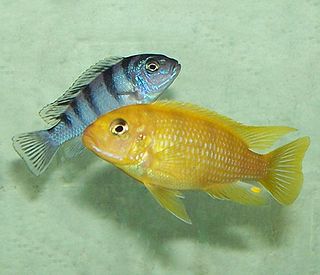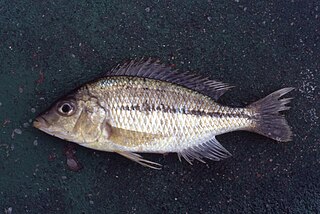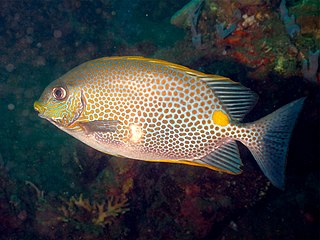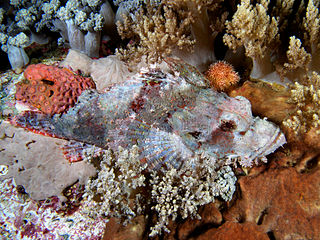
The oscar is a species of fish from the cichlid family known under a variety of common names, including tiger oscar, velvet cichlid, and marble cichlid. In tropical South America, where the species naturally resides, A. ocellatus specimens are often found for sale as a food fish in the local markets. The fish has been introduced to other areas, including India, China, Australia, and the United States. It is considered a popular aquarium fish in Europe and the U.S.

Pterophyllum leopoldi, also referred to as the teardrop angelfish, Leopold's angelfishdwarf angelfish, or roman-nosed angelfish, is an angelfish species native to the Amazon River, Essequibo River and Rupununi River.

The threadfin rainbowfish or featherfin rainbowfish is a rainbowfish, the only species in the genus Iriatherina. It is characterized by long beautiful fins, and is among the most attractive of the rainbowfishes.

Johann Jakob Heckel was an Austrian taxidermist, zoologist, and ichthyologist from Mannheim in the Electoral Palatinate.

Maylandia lombardoi, is a 13 centimetres (5.1 in) long freshwater fish from the family Cichlidae. This species is popular in the aquarium hobby where it is sold under a variety of common names including: lombardoi mbuna, kenyi mbuna or kennyi mbuna or kenyi cichlid. This species is sometimes seen in the genus Metriaclima owing to a dispute in which a minority of cichlid researchers do not consider Maylandia valid (see Maylandia for discussion. The specific name honours the exotic fish dealer John Lombardo.

The keyhole cichlid is a cichlid fish endemic to tropical South America, occurring in the lower Orinoco Basin in Venezuela and river basins in The Guianas. It is the only species in the genus Cleithracara. The species is popular with fishkeeping hobbyists and is frequently kept in aquariums.

Nimbochromis livingstonii, Livingston's cichlid or (locally) kalingono, is a freshwater mouthbrooding cichlid native to Lake Malawi, an African Rift Lake. It is also found in the upper Shire River and Lake Malombe. They are found in inshore areas of the lake over sandy substrates.

Satanoperca is a small genus of cichlids from South America, where they are known from the Orinoco, Essequibo, Nickerie, Amazon and Paraná–Paraguay river basins. They are mainly found in areas with slow-moving waters, but some species have also been recorded from rapids.

Mesonauta, the flag cichlids, is a small genus of cichlids native to the Amazon, Orinoco, Essequibo, Paraná and Paraguay basins in South America. Mesonauta is included in the subfamily Cichlasomatinae. They occur in various freshwater habitats such as streams and lakes, especially in areas with little water movement and aquatic vegetation. They are generally found in small groups that stay near the water surface. To avoid predators, adults may jump out of the water and juveniles mimic leaves.

Copadichromis borleyi is a species of haplochromine cichlid fish endemic to Lake Malawi in East Africa. The species is popular in the fishkeeping hobby where it is frequently kept in aquariums. The species has numerous common names, including redfin hap and goldfin hap.

The convict julie is a cichlid species in the subfamily Pseudocrenilabrinae family endemic to Lake Tanganyika. Hence it is found in Burundi, the Democratic Republic of the Congo, Tanzania, and Zambia. The fish is named after Charles Tate Regan.
The threadfin cichlid is a species of cichlid endemic to Lake Tanganyika found in areas with rocky substrates on which it can graze on algae. This species can reach a length of 18 cm (7.1 in). It can be found in the aquarium trade. The specific name of this cichlid honours the British ichthyologist Ethelwynn Trewavas (1900-1993).

Protomelas kirkii is a species of cichlid endemic to Lake Malawi where it is most commonly found in areas vegetated with Vallisneria. This species can reach a length of 18 centimetres (7.1 in) TL. This species can also be found in the aquarium trade.

Centropyge tibicen, the keyhole angelfish, black angelfish, whitespot angelfish or puller angelfish, is a species of marine ray-finned fish, a marine angelfish belonging to the family Pomacanthidae. It is found in the Indo-Pacific region.

The orange-spotted spinefoot, also known as the deepbody spinefoot, gold-saddle rabbitfish, golden rabbitfish, golden-spotted spinefoot, goldlined spinefoot or yellowblotch spinefoot, is a species of marine ray-finned fish, a rabbitfish belonging to the family Siganidae. It is found in the eastern Indian Ocean and western Pacific Ocean. It occasionally makes its way into the aquarium trade.

Apistogramma agassizii, commonly known as Agassiz's dwarf cichlid, is a species of cichlid found in the Marañón and Ucayali River in Peru, some tributaries of the Amazon River, as well as downstream to the estuary in the Atlantic. It is named after the Swiss-American zoologist and geologist Louis Agassiz (1807-1873).

The green swordtail is a species of freshwater/brackish fish in family Poeciliidae of order Cyprinodontiformes. A live-bearer, it is closely related to the southern platyfish or 'platy' and can crossbreed with it. It is native to an area of North and Central America stretching from Veracruz, Mexico, to northwestern Honduras.

Scorpaenopsis neglecta, the yellowfin scorpionfish or bandtail scorpionfish, is a species of venomous marine ray-finned fish belonging to the family Scorpaenidae, the scorpionfishes. It is found in the Indo-West Pacific.

Australoheros facetus, the chameleon cichlid or chanchito, is a species of cichlid from the subfamily Cichlasomatinae which is native to northern Argentina, Paraguay, Uruguay and southern Brazil.
Crenicichla heckeli is a species of cichlid native to South America. It is found in the Amazon River basin and in the Trombetas River close to Cachoeira Porteira, Brazil. This species reaches a length of 5.2 cm (2.0 in).



















